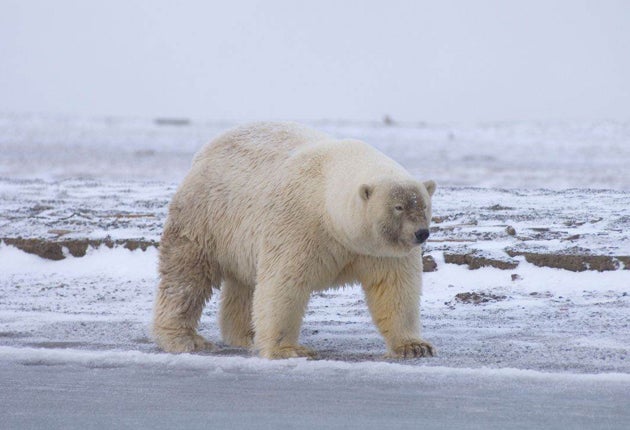Arctic's vanishing sea ice presents polar bear with a new danger – grizzlies
Fears for future of gene pool as interbreeding between vulnerable species driven together by global warming gathers pace

The rapid loss of sea ice in the Arctic is encouraging the formation of hybrids between related species which could accelerate the decline of some of the region's most vulnerable animals, a study has found.
Scientists believe that the diminishing area of the Arctic Ocean that is covered by floating sea ice is forcing the polar bear to come into closer contact with the related grizzly bear, resulting in hybrids that could threaten the distinctive gene pool of both species.
Other examples of hybrids in the Arctic region include a narwhal-beluga whale cross found in west Greenland and an apparent hybrid of a bowhead and right whale photographed in the Bering Sea in 2009. Porpoises and seals are also known to be involved in cross-breeding, the researchers said.
The first polar-grizzly hybrid to be spotted in the wild was shot by hunters in 2006. It was a white bear with brown patches and DNA tests subsequently confirmed that it was the result of cross breeding between the two species.
Although hybrids were known from captive bears kept in zoos, none had been confirmed in the wild. However, earlier this year another hybrid was killed by a hunter in the western Canadian Arctic and tests confirmed that it was a second-generation hybrid – the offspring of a hybrid female and a pure-bred grizzly bear male.
Scientists said that more cases of polar-grizzly bear hybrids are probably out there waiting to be discovered because of the change in behaviour of the polar bear brought about by climate change. They are spending more time on shore waiting for the sea ice to form, bringing them into close contact with grizzlies.
Brendan Kelly of the US National Marine Mammal Laboratory in Juneau, Alaska, led a study that found 34 possible hybridisations between discreet populations or species of large mammals living in or near to the Arctic. Twenty-two of these cases involved isolated populations at risk of intermixing.
"The Arctic Ocean is predicted to be ice-free in summer before the end of the century, removing a continent-sized barrier to interbreeding. Polar bears are spending more time in the same areas as grizzlies; seals and whales currently isolated by sea ice will soon be likely to share the same waters," Dr Kelly and his colleagues report in the journal Nature.
"Not all cross-species matings will produce viable, or indeed any, offspring. The chance is enhanced in Arctic marine mammals because their number of chromosomes has changed little over time," they said.
Although the creation of hybrids is a natural feature of evolution, scientists believe the speed and extent of hybridisation in the Arctic due to the rapid loss of sea ice could have major implications, especially for specialised animals such as the polar bear which has to rely on highly evolved behaviour.
For example, zoologists studying polar-grizzly hybrids in a German zoo found that they exhibited typical polar-bear behaviour associated with seal hunting but they lacked the strong swimming abilities of the Arctic bears, which have to roam vast areas of sea ice during the winter months to hunt for seals.
Andrew Whiteley of the University of Massachusetts said that interbreeding between species may be especially problematic for rare and endangered animals. There are only about 200 North Pacific right whales in the wild, for instance, and their existence could be jeopardised by hybridising with the more numerous bowhead whales. "Hybridising can cause a lost of biodiversity. Distinct lineages that evolved over millenia can become mixed," Dr Whiteley said.
Scientists estimate there are about 22,000 polar bears in the Arctic region and the population could fall to a third by mid-century if the sea ice continues to decline at current rates, leading to the loss of all summer ice by 2060.
However, a separate study published in Nature has found that this decline of polar bears could easily be reversed if greenhouse gas emissions were cut drastically within the next 10 years, which could curb or even reverse the loss of sea ice.
Join our commenting forum
Join thought-provoking conversations, follow other Independent readers and see their replies
0Comments